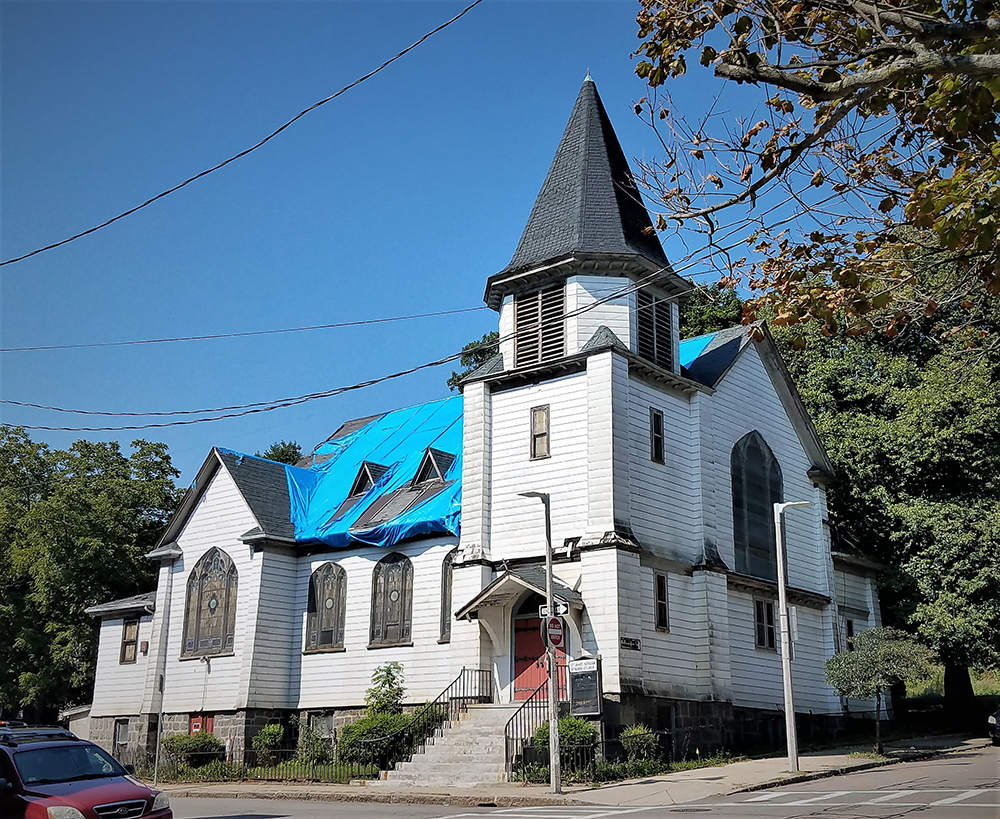
28 Feb 2019 Garvey, McGuire, and God: The Origins of the African Orthodox Church
The St. James African Orthodox Church has been an icon in the Highland Park neighborhood since its construction on the corner of Cedar Street and Hawthorne Street in 1910. Originally built for a Norwegian Evangelical congregation, the church changed hands to the African Orthodox Church in 1955 as the area became a concentrated center for African American residents. The neighborhood and church provided the perfect environment for the growing African Orthodox congregation, an off-shoot of Marcus Garvey’s Universal Negro Improvement Association (UNIA).
Though Garvey was never a member of the church, he widely publicized his desire for the creation of an independent national church for African Americans. As evidenced by a speech he delivered at Harlem’s famed Liberty Hall, self-determination was central to Garvey’s ideology: “If you want Liberty, you yourselves must strike the blow. If you must be free, you must become so through your own effort, through your own initiative”. In the 1910s, Garvey actively scouted for a clergyman who might spearhead the movement and foster religious autonomy for black congregations.

George Alexander McGuire November 10 1934
In 1918, Garvey met a young priest who had immigrated from Antigua in 1894: George Alexander McGuire, a student of the Moravian Miskey Seminary in the Danish West Indies. Both shared visions of an African diaspora that would draw strength from their shared Pan-African heritage and wield that power to demand racial equality. McGuire was no stranger to racial inequality, which he had encountered from the Episcopal Church in the US and at home in British-controlled Antigua.
In his early years in the United States, McGuire joined the African Methodist Episcopal Church, but quickly joined the Episcopal Church, and was ordained as a priest. As a clergyman, McGuire was head of a number of parishes including congregations in Cincinnati, Ohio; Philadelphia, Pennsylvania; St. Philip’s Episcopal Church of Richmond, Virginia; and Little Rock, Arkansas. McGuire’s church in Philadelphia was the city’s first black Episcopal Church.
Despite an accomplished record of leading parishes, during his time in Arkansas, McGuire faced fierce, racially-based resistance from the local Episcopal bishops, leading to his resignation from the church. McGuire made his way north to Cambridge where he established St. Bartholomew’s Church, home to a largely West Indian congregation. While in Cambridge, McGuire attended Boston College of Physicians and Surgeons, where he earned his M.D. in 1910. Facing more pressure from the Episcopal clergy in Cambridge, McGuire resigned again in 1911.
After a five-year hiatus in Antigua, spent as a minister for the Church of England in Antigua, McGuire returned to the U.S. and moved to New York City. In New York, McGuire created the Independent Episcopal Church of the Good Shepherd, which would become the basis for the African Orthodox Church.
McGuire’s return brought him into orbit with Garvey. In the first years of their relationship, Garvey and McGuire served as elected leaders of UNIA, President-General and chaplain-general, respectively. During this time, McGuire crafted an official liturgy for the group entitled the “Universal Negro Ritual” and the “Universal Negro Catechism”. Through his work, McGuire attempted to mold the UNIA into a Christian black-nationalist organization; however, Garvey discouraged the group from claiming a single branch of religion, fearing that it would negatively affect UNIA membership.
By September of 1921, weeks after Garvey’s speech at Liberty Hall, McGuire had decided to leave the UNIA to form his own church, The Independent Episcopal Church. By 1924, the church would officially be known as the African Orthodox Church, which would serve a congregation of black-nationalist neo-Anglican members. The church maintained strong ties with the UNIA, though Garvey was unwilling to tie the organization to the church.
Following the ideology of UNIA, the African Orthodox Church formed around a constitution which stated: “the name of this church, which was organized September 2nd, 1921, is and shall be the African Orthodox Church. its faith as declared, is orthodox, in conformity with the orthodox churches of the east from which its episcopate is derived. while it admits to membership and other privileges persons of all races, it seeks particularly to reach out to the millions of African descent in both hemispheres, and declares itself to be perpetually autonomous and controlled by negroes. Hence the name, African Orthodox”.
For more on the history of the church, read:
• https://www.blackpast.org/african-american-history/mcguire-george-alexander-1866-1934/
• A Note on the Origin of the African Orthodox Church, Byron Rushing, Massachusetts Institute of Technology. 1972.



